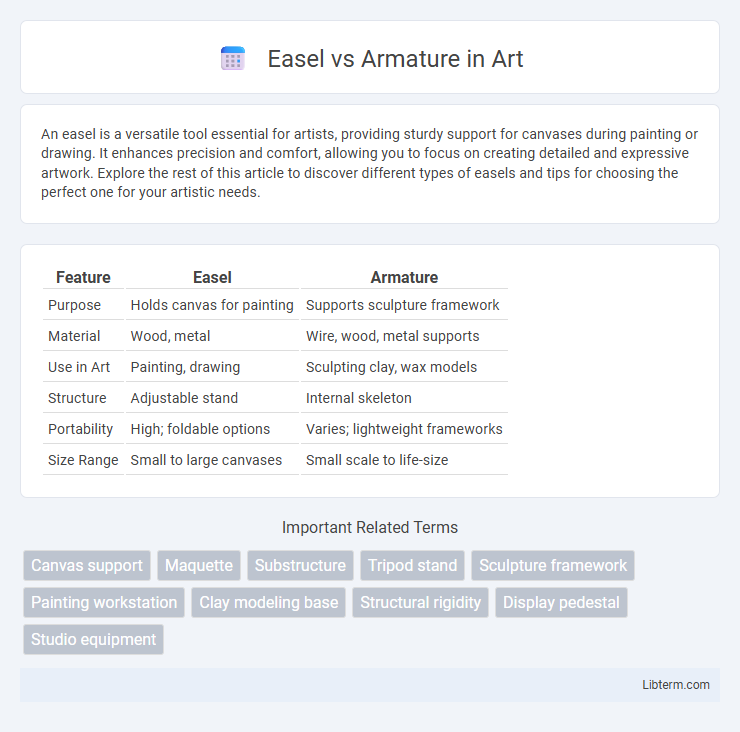An easel is a versatile tool essential for artists, providing sturdy support for canvases during painting or drawing. It enhances precision and comfort, allowing you to focus on creating detailed and expressive artwork. Explore the rest of this article to discover different types of easels and tips for choosing the perfect one for your artistic needs.
Table of Comparison
| Feature | Easel | Armature |
|---|---|---|
| Purpose | Holds canvas for painting | Supports sculpture framework |
| Material | Wood, metal | Wire, wood, metal supports |
| Use in Art | Painting, drawing | Sculpting clay, wax models |
| Structure | Adjustable stand | Internal skeleton |
| Portability | High; foldable options | Varies; lightweight frameworks |
| Size Range | Small to large canvases | Small scale to life-size |
Introduction to Easel and Armature
An easel is a stand designed to hold a canvas or board steady while an artist paints or draws, facilitating ease of access and proper positioning. An armature is a supportive framework, often made from wire or metal, used as the skeleton beneath sculptures or three-dimensional artworks to provide stability and shape. Both tools serve distinct roles in artistic creation, with easels primarily aiding in two-dimensional work and armatures supporting three-dimensional forms.
Definition and Purpose of an Easel
An easel is a freestanding frame designed to hold a canvas or drawing board upright while an artist works, providing stability and adjustable angles for optimal comfort. Its primary purpose is to support paintings or sketches during creation, allowing for better control over brush strokes and composition. Armatures, in contrast, serve as internal frameworks that provide structural support to sculptures or three-dimensional artwork, shaping and maintaining the form before adding outer materials.
Definition and Purpose of an Armature
An armature is a flexible framework used by artists to support and shape sculptures or models, providing structural stability and ease of manipulation during the creation process. Unlike an easel, which serves as a stand to hold canvases for painting, an armature functions as the internal skeleton that maintains form and proportion in three-dimensional art. Its primary purpose is to enable artists to build complex, dynamic shapes with durability and precision before applying final materials like clay or plaster.
Key Differences Between Easel and Armature
Easels are freestanding frames designed to support canvases or drawing boards during painting or sketching, emphasizing portability and adjustable height for user comfort. Armatures serve as internal frameworks or skeletons used in sculpture and modeling to provide structural support and shape to materials like clay or plaster. The key difference lies in function: easels facilitate the presentation and working angle of artworks, while armatures ensure stability and form during the creation process.
Common Materials Used for Easels and Armatures
Common materials used for easels include wood, aluminum, and steel, chosen for their durability, stability, and portability. Armatures, primarily utilized in sculpture and animation, are typically crafted from wire, aluminum rods, or wooden dowels, enabling flexible support and articulation of the model. Both easels and armatures require materials that balance strength and maneuverability to accommodate various artistic techniques and mediums.
Pros and Cons of Using Easels
Easels offer excellent portability and adjustable angles, making them ideal for artists working in various environments and poses. However, they can lack stability and may not support heavy or large canvases effectively, potentially causing wobbling during detailed work. Their design favors traditional painting techniques but might be less suitable for mixed media or sculpture projects requiring more robust support.
Pros and Cons of Using Armatures
Using armatures offers precise control over complex poses and movements, making them ideal for detailed stop-motion animation and sculpting projects requiring flexibility and durability. However, armatures can be time-consuming to create and adjust, potentially complicating the animation process compared to using an easel. Their metal or wire framework may also limit surface texture options, impacting the overall aesthetic in certain artistic applications.
Choosing Between Easel and Armature: Factors to Consider
Selecting between an easel and an armature depends on the specific artistic requirements and workspace constraints. Easels provide adjustable support primarily for canvases, ideal for painters seeking stability and various angles, while armatures offer a flexible framework for sculptors or mixed-media artists needing three-dimensional support. Consider factors such as medium, scale, portability, and the type of artistic manipulation when deciding the most suitable support structure.
Best Practices for Using Easels and Armatures in Art
Using easels and armatures effectively enhances artistic precision and stability; easels provide adjustable support for canvases, promoting proper posture and reducing fatigue during painting. Armatures are essential for sculpting, offering a sturdy framework that maintains the shape and proportion of clay or other materials while working. Best practices include selecting the right size and type for the project, regularly checking for secure stability, and positioning tools ergonomically to optimize workflow and accuracy.
Conclusion: Easel vs Armature—Which Is Right for You?
Choosing between an easel and an armature depends on your artistic needs and workspace constraints. Easels offer sturdy support and adjustable angles ideal for traditional painting styles, while armatures provide a flexible framework essential for sculpting and three-dimensional work. Assessing your medium and creative process helps determine the best tool to enhance your artistic expression.
Easel Infographic

 libterm.com
libterm.com